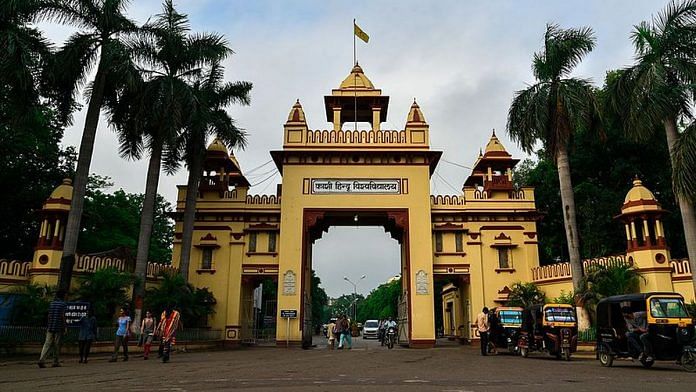New Delhi: The Banaras Hindu University’s Faculty of Law was ranked 19th in the National Institutional Ranking Framework (NIRF) for 2020, based on the data it provided to the National Board of Accreditation (NBA) earlier this year.
The university has, however, now told ThePrint that it does not have any such data as it does not collect students data in the first place.
NIRF is the Narendra Modi government’s answer to international evaluation systems such as QS and Times Higher Education Ranking. The Indian rankings, released on 11 June this year, rely on the data the institutions submit to the NBA, which comes under the Ministry of Education and is the ranking agency for the NIRF.
According to the data BHU’s law faculty shared with the NBA, all 60 of its students in the five-year BA LLB programme graduated in the minimum stipulated time in the 2018-19 academic year. It had also claimed that 35 of them were placed at a median salary of Rs 8 lakh per annum. This data is in public domain and can be accessed on the Ministry of Education website.
However, when ThePrint sought details of the placements through an application filed under the Right To Information Act, the law department said it does not collect such information.
The RTI plea was filed on 20 June after several students accused the department of falsifying data.
Also read: Modi govt working on students’ ‘credit bank’ to start 4-yr undergraduate programme from 2021
Don’t have such data: BHU law faculty
ThePrint’s RTI application had three questions — the list of the BA LLB students who secured campus placements; a list of the organisations they got placed into; and the estimated salary offered by these organisations.
In response to the question on the list of students, the BHU reply said, “The B.A. L.L.B. Honours five-year degree course is a professional course whose purpose is to educate students so as they could either join the bar as a lawyer or the bench as judge. As per the practice followed by this institution and other law colleges affiliated to various central universities, joining the legal profession as lawyer is also considered as deemed placement.”
Responding to the second question, on the organisations that recruited students, BHU said, “No such kind of record is prepared and kept by the faculty of law BHU.”
On the question of estimated salaries offered to those who secured placements, BHU said, “There is no limit to earning to those joining the bar. Those who join the bench get salary as per government rules.”
ThePrint sent an email on 4 August to the Ministry of Education (through the Press Information Bureau) and the authorities at BHU seeking an explanation for the contradictory information.
While BHU responded, the ministry is yet to do so.
However, while the ThePrint’s email to BHU was addressed to Vice-Chancellor Rakesh Bhatnagar and Law Faculty Dean R.P. Rai, the response came from Dr Bhartendu K. Singh, professor in the physics department, who had been responsible for sending BHU’s overall data to the NBA for the NIRF ranking.
“We need to check the data from the Faculty of Law. I am requesting Dean, Faculty of Law, to respond to your concern at the earliest with a cc to us,” Singh wrote on 10 August.
ThePrint was also marked in an email sent to the law faculty by BHU’s Internal Quality Assurance Cell Vice-Chairman A. Vaishampayan on the same day.
“Please respond to the trailing mail on the subject ‘Response for media query: mismatch in the data given by BHU for the NIRF ranking, related to UG data under the Faculty of Law’. This is for your URGENT necessary action, under information to the Coordinator (IQAC-BHU),” he wrote.
Rai is, however, yet to respond to both mails.
Also read: JEE aspirants have to sign Covid undertaking to write tests as SC refuses to postpone exam
The NIRF ranking
BHU’s Faculty of Law ranks 19th among the 20 colleges on the NIRF list.
The NIRF was approved by the HRD ministry on 29 September 2015. The idea behind it was to develop an Indian evaluation system on par with QS and Times Higher Education Ranking.
Indian higher education institutions have time and again questioned the parameters and the transparency of the QS and Times Higher Education Rankings. In fact, seven IITs decided not to participate in these rankings in 2020.
The NIRF ranks institutions in 10 categories. BHU, for instance, finished third in the overall category.
For individual categories, such as law colleges, NIRF has five parameters, including teaching-learning and perception. One of the parameters is graduation outcomes (GO), which includes combined metrics for placement, higher studies, and entrepreneurship (GPHE), a metric for university examinations (GUE), median salary (GMS), and a metric for graduating students admitted into top universities.
“We do not verify the data always,” said an NBA official, who spoke to ThePrint on condition of anonymity.
“Number of participants in the NIRF in 2020 has been more than 5,800. Collecting the original documents from all of them and verifying it is not possible. We expect the participants to be honest and believe that the competitors will check each others’ data.”
The official added that when there is any doubt on any institution’s details, original documents are asked for and the data is verified. Even then, if some discrepancy is found, the institution is first warned and then taken off the ranking list.
Also read: ‘Will give students what they get abroad’ — India plans tie-ups with top 100 universities




Can you share a copy of that RTI?
NIRF data is only indicative. It can’t be believed on face value. Lot of unverifiable data (mostly false) is given to get good ranking. For last two decades, BHU’s performance is not that good. Regionalism has engulfed BHU. Progressively, it is on the way to become an average University.